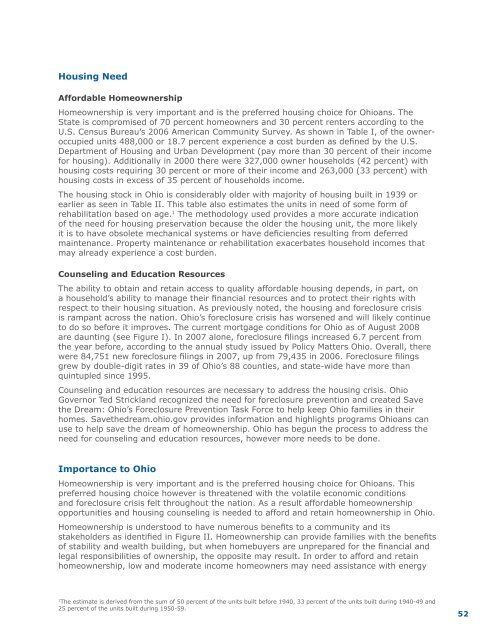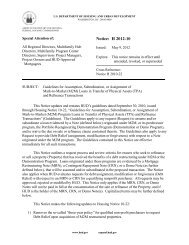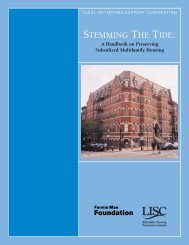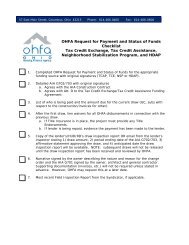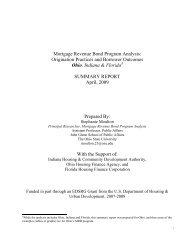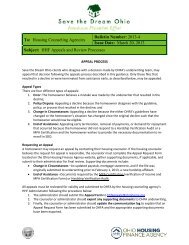OHFA Annual Plan - Ohio Housing Finance Agency
OHFA Annual Plan - Ohio Housing Finance Agency
OHFA Annual Plan - Ohio Housing Finance Agency
You also want an ePaper? Increase the reach of your titles
YUMPU automatically turns print PDFs into web optimized ePapers that Google loves.
<strong>Housing</strong> NeedAffordable HomeownershipHomeownership is very important and is the preferred housing choice for <strong>Ohio</strong>ans. TheState is compromised of 70 percent homeowners and 30 percent renters according to theU.S. Census Bureau’s 2006 American Community Survey. As shown in Table I, of the owneroccupiedunits 488,000 or 18.7 percent experience a cost burden as defined by the U.S.Department of <strong>Housing</strong> and Urban Development (pay more than 30 percent of their incomefor housing). Additionally in 2000 there were 327,000 owner households (42 percent) withhousing costs requiring 30 percent or more of their income and 263,000 (33 percent) withhousing costs in excess of 35 percent of households income.The housing stock in <strong>Ohio</strong> is considerably older with majority of housing built in 1939 orearlier as seen in Table II. This table also estimates the units in need of some form ofrehabilitation based on age. 1 The methodology used provides a more accurate indicationof the need for housing preservation because the older the housing unit, the more likelyit is to have obsolete mechanical systems or have deficiencies resulting from deferredmaintenance. Property maintenance or rehabilitation exacerbates household incomes thatmay already experience a cost burden.Counseling and Education ResourcesThe ability to obtain and retain access to quality affordable housing depends, in part, ona household’s ability to manage their financial resources and to protect their rights withrespect to their housing situation. As previously noted, the housing and foreclosure crisisis rampant across the nation. <strong>Ohio</strong>’s foreclosure crisis has worsened and will likely continueto do so before it improves. The current mortgage conditions for <strong>Ohio</strong> as of August 2008are daunting (see Figure I). In 2007 alone, foreclosure filings increased 6.7 percent fromthe year before, according to the annual study issued by Policy Matters <strong>Ohio</strong>. Overall, therewere 84,751 new foreclosure filings in 2007, up from 79,435 in 2006. Foreclosure filingsgrew by double-digit rates in 39 of <strong>Ohio</strong>’s 88 counties, and state-wide have more thanquintupled since 1995.Counseling and education resources are necessary to address the housing crisis. <strong>Ohio</strong>Governor Ted Strickland recognized the need for foreclosure prevention and created Savethe Dream: <strong>Ohio</strong>’s Foreclosure Prevention Task Force to help keep <strong>Ohio</strong> families in theirhomes. Savethedream.ohio.gov provides information and highlights programs <strong>Ohio</strong>ans canuse to help save the dream of homeownership. <strong>Ohio</strong> has begun the process to address theneed for counseling and education resources, however more needs to be done.Importance to <strong>Ohio</strong>Homeownership is very important and is the preferred housing choice for <strong>Ohio</strong>ans. Thispreferred housing choice however is threatened with the volatile economic conditionsand foreclosure crisis felt throughout the nation. As a result affordable homeownershipopportunities and housing counseling is needed to afford and retain homeownership in <strong>Ohio</strong>.Homeownership is understood to have numerous benefits to a community and itsstakeholders as identified in Figure II. Homeownership can provide families with the benefitsof stability and wealth building, but when homebuyers are unprepared for the financial andlegal responsibilities of ownership, the opposite may result. In order to afford and retainhomeownership, low and moderate income homeowners may need assistance with energy1The estimate is derived from the sum of 50 percent of the units built before 1940, 33 percent of the units built during 1940-49 and25 percent of the units built during 1950-59.52


